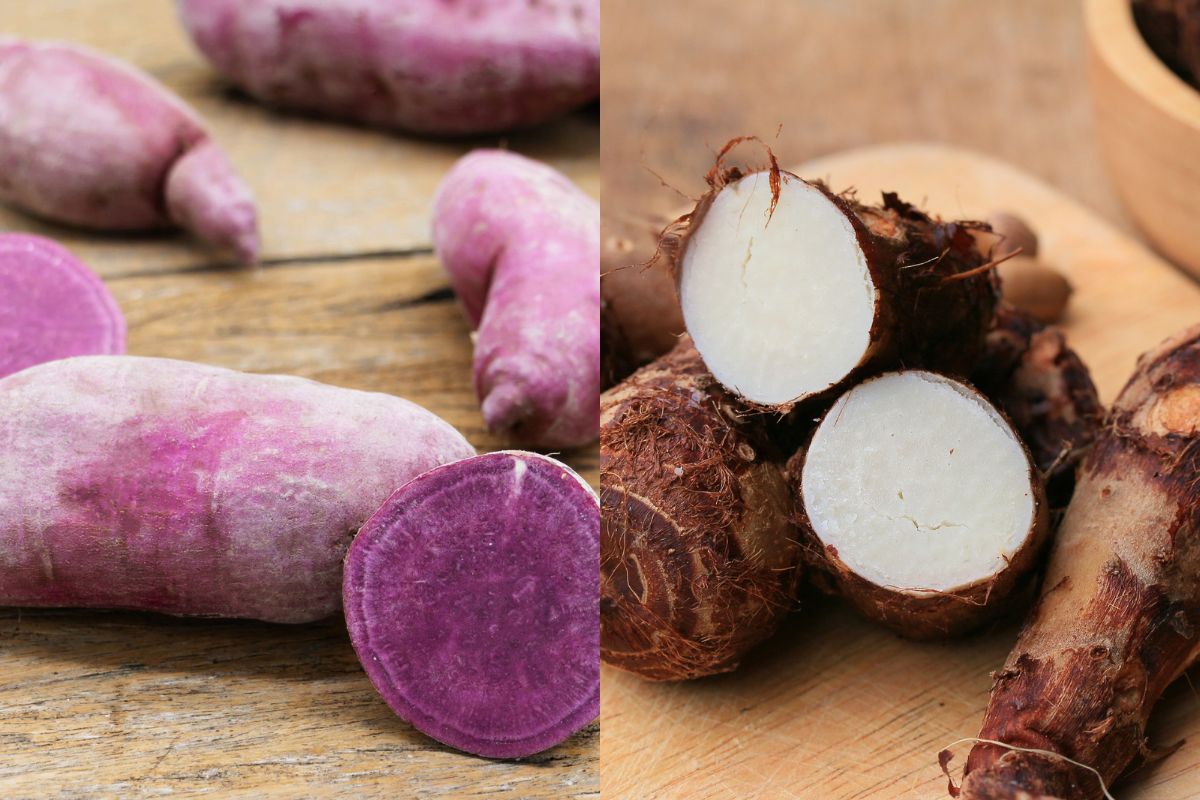Beyond Purple: Understanding Ube's Cultural Heritage
Zoey Tabin van SpallShare
 In recent years, a vibrant purple treasure has captured global imagination. The journey of this humble root crop from traditional Filipino kitchens to global inspiration opens important conversations about cultural representation and education. As social media feeds showcase this cherished heritage and global brands embrace its growing presence, ube stands at the centre of this cultural renaissance. While this increased visibility brings excitement to Filipino communities, it also presents an opportunity to share the deep cultural significance behind this beloved tradition.
In recent years, a vibrant purple treasure has captured global imagination. The journey of this humble root crop from traditional Filipino kitchens to global inspiration opens important conversations about cultural representation and education. As social media feeds showcase this cherished heritage and global brands embrace its growing presence, ube stands at the centre of this cultural renaissance. While this increased visibility brings excitement to Filipino communities, it also presents an opportunity to share the deep cultural significance behind this beloved tradition.
The Cultural Identity of Ube
Ube, while cultivated across Southeast Asia, has become particularly significant in Filipino cuisine and culture. More than just a trending ingredient, it represents generations of cultural knowledge, community celebrations, and family traditions passed down through time. Like many treasured elements of Filipino culture, ube carries stories of resilience, adaptation, and the preservation of heritage across generations.
Traditional Farming and Cultivation
 The art of ube cultivation in the Philippines tells a story of agricultural wisdom passed through generations. Across the archipelago's diverse landscapes, from misty mountain slopes to fertile lowland fields, each region has developed its own relationship with this precious crop.
The art of ube cultivation in the Philippines tells a story of agricultural wisdom passed through generations. Across the archipelago's diverse landscapes, from misty mountain slopes to fertile lowland fields, each region has developed its own relationship with this precious crop.
Key Growing Regions:
❀ Northern Luzon
❀ Southern Tagalog
❀ Bicol Region
❀ Central Visayas
❀ Northern Mindanao
These distinct regions have given rise to unique cultivation methods, each adapted to local conditions and traditions. Farmers work in harmony with seasonal rhythms, employing traditional cultivation methods such as:
❀ Seasonal planting aligned with monsoon cycles
❀ Intercropping with complementary plants
❀ Natural fertilisation techniques
❀ Traditional pest management practices
The Art of Preparation: Traditional Methods

The transformation of ube from root to delicacy is a testament to Filipino culinary artistry. This knowledge, passed down through generations, reflects the communal nature of Filipino food preparation. The creation of ube halaya (purple yam jam) exemplifies this tradition - from the careful peeling and grating of fresh ube to the patient process of slow cooking with coconut milk, continuous stirring, and finally setting in traditional banana leaf-lined moulds.
Traditional storage methods showcase the ingenuity of Filipino preservation techniques, from underground storage in cool, dry areas to wrapping in banana leaves and using bamboo containers. These methods, aligned with seasonal harvest cycles, ensure ube's availability throughout the year.
Understanding Ube and Taro: A Tale of Two Purple Roots
 In the global food scene, purple-hued ingredients often spark curiosity and sometimes confusion. While both ube and taro have captured culinary imaginations worldwide, these two roots tell distinctly different stories through their characteristics and cultural significance.
In the global food scene, purple-hued ingredients often spark curiosity and sometimes confusion. While both ube and taro have captured culinary imaginations worldwide, these two roots tell distinctly different stories through their characteristics and cultural significance.
Ube (Dioscorea alata) Characteristics:
❀ Vibrant purple interior
❀ Yam-like exterior
❀ Sweet, vanilla-like flavour
❀ Primarily used in desserts
❀ Deep Filipino cultural significance
In contrast, taro root (Colocasia esculenta) presents its own unique profile:
❀ Light interior with purple specks
❀ Dark brown exterior
❀ Earthy/nutty flavour
❀ Versatile in sweet and savoury dishes
❀ Pan-Asian cultural significance
Health Benefits and Traditional Applications
Beyond its captivating colour and rich cultural heritage, ube has been integral to Filipino culture since pre-colonial times. Historically, ube was valued not just for its nutritional sustenance but also for its traditional wellness applications across Southeast Asia. Its distinctive purple hue is attributed to natural compounds called anthocyanins, which are known for their antioxidant properties. These compounds contribute not only to ube's visual appeal but also to its potential health benefits.
Modern research suggests that ube may offer several health-supporting properties through its nutritional content:
❀ Potassium and Minerals: Essential for heart health and muscle function.
❀ Vitamins A and C: Vital for immune support and skin health.
❀ Dietary Fibre: Promotes digestive health and may aid in blood sugar regulation.
❀ Antioxidants, particularly Anthocyanins: May help reduce inflammation and support cognitive function.
Preservation and Commercialisation in the Digital Age
 In today's interconnected world, ube's story has entered a new chapter, one that brings both opportunities and challenges. While digital platforms enable unprecedented cultural sharing and preservation, they've also led to rapid commercialisation that sometimes overlooks deep cultural significance.
In today's interconnected world, ube's story has entered a new chapter, one that brings both opportunities and challenges. While digital platforms enable unprecedented cultural sharing and preservation, they've also led to rapid commercialisation that sometimes overlooks deep cultural significance.
The digital revolution has transformed how Filipino culinary traditions are preserved and shared. Through social media and online platforms, recipe tutorials and cultural storytelling bridge generations, while virtual gatherings have become modern versions of traditional Filipino festivities. Online cooking classes and cultural workshops create spaces where families connect across continents, fostering both learning and celebration. These virtual bridges ensure that even as Filipino communities spread across the globe, their connections to home and heritage remain strong.
Cultural Innovation: Filipino-Led Businesses in the UK
The UK's vibrant food scene has become a testament to the growing appreciation of Filipino cuisine. While London remains the epicentre of Filipino culinary innovation, with the highest concentration of Filipino-owned establishments, there's a growing presence of Filipino businesses sprinkled across Manchester, Birmingham, and other major UK cities. These establishments have found innovative ways to share ube with wider audiences - from artisanal ice cream parlours to modern dessert shops.
Their success extends beyond creating delicious treats; they serve as cultural ambassadors, weaving together heritage preservation and community building. Through documenting traditional preparation methods and sharing authentic family recipes, these businesses create vital spaces for cultural exchange and intergenerational connection. They've become community hubs, providing gathering spaces for Filipino communities while creating employment opportunities within the diaspora. Through supporting cultural events and festivals, they foster a deep sense of pride in Filipino heritage, ensuring traditions continue to thrive across the UK.
Moving Forward: Cultural Appreciation in a Global Context
 From traditional Filipino kitchens to modern wellness practices, ube has evolved while maintaining its cultural significance. Its beauty lies in its ability to adapt while staying true to its essence. In every bite of ube halaya or any ube-infused dessert, not only is there a taste of sweet vanilla flavour and vibrant colour, but also a connection to centuries of tradition and the ongoing journey of this remarkable ingredient.
From traditional Filipino kitchens to modern wellness practices, ube has evolved while maintaining its cultural significance. Its beauty lies in its ability to adapt while staying true to its essence. In every bite of ube halaya or any ube-infused dessert, not only is there a taste of sweet vanilla flavour and vibrant colour, but also a connection to centuries of tradition and the ongoing journey of this remarkable ingredient.
As ube continues its journey from traditional ingredient to global phenomenon, mindful appreciation becomes increasingly important. Understanding its cultural history, learning traditional preparation methods, and supporting Filipino producers ensures this beloved ingredient's heritage remains honoured while its global appreciation grows. Through respectful engagement with ube's cultural significance, we can celebrate both its traditional roots and its evolving role in global cuisine.
